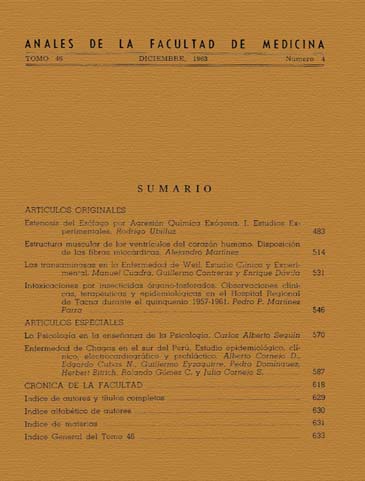Esophageal Stenosis due to Exogenous Chemical Injury
DOI:
https://doi.org/10.15381/anales.v46i4.5846Abstract
Erosive esophagitis in 34 dogs was produced by instillation transesofagoscópica commercial bleach or sodium hydroxide solutions and existing lesions at 13, 21 and 30 days duration was studied. In 8 animals the spontaneous evolution of corrosívcs esophageal lesions , verifying abundance of young fibroblasts , incipient fibrosis and occlusive vascular lesions to the second week of aggression was analyzed. Between 21 and 35 days fibrosis had been outstanding . 14 dogs were divided into three subqrupos and violated with sodium hydroxide solutions of increasing concentrations ( 2.5 N, 5 N and 10 N ) . The immediate mortality was very high in all three subqrupos . The severity of the inflicted damage increased as a direct function of the concentration of the corrosive agent , showing that any clinical or therapeutic assessment should consider the influence of this factor . No favorable effect of parenteral chymotrypsin was observed in the group of animals subjected to the previous experience. Intramuscular administration of adrenocorticotropic hormone to 9 animals allowed to observe rapid attenuation of dysphagia and the healing process , without stenosis removed . Moreover, this group recorded the largest number of micro - perforations and abscesses of the etched walls. ACTH action was similar to that described for the adrenocortical hormones.Downloads
Published
1963-12-30
Issue
Section
Trabajos originales
License
Copyright (c) 1963 Rodrigo Ubilluz Dhaga del Castillo

This work is licensed under a Creative Commons Attribution-NonCommercial-ShareAlike 4.0 International License.
Those authors who have publications with this magazine accept the following terms:
- Authors will retain their copyrights and guarantee the journal the right of first publication of their work, which will be simultaneously subject to Creative Commons Attribution License that allows third parties to share the work as long as its author and its first publication this magazine are indicated.
- Authors may adopt other non-exclusive licensing agreements for the distribution of the version of the published work (eg, deposit it in an institutional electronic file or publish it in a monographic volume) provided that the initial publication in this magazine is indicated.
- Authors are allowed and recommended to disseminate their work over the Internet (eg: in institutional telematic archives or on their website) before and during the submission process, which It can produce interesting exchanges and increase quotes from the published work. (See El efecto del acceso abierto ).
How to Cite
1.
Ubilluz Dhaga del Castillo R. Esophageal Stenosis due to Exogenous Chemical Injury. An Fac med [Internet]. 1963 Dec. 30 [cited 2024 Jul. 17];46(4):485-513. Available from: https://revistasinvestigacion.unmsm.edu.pe/index.php/anales/article/view/5846















